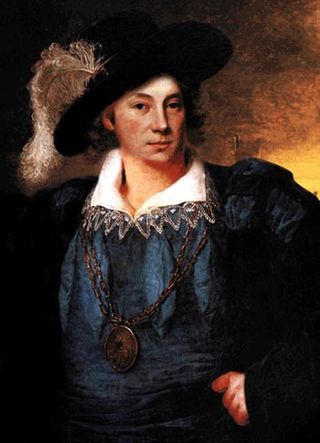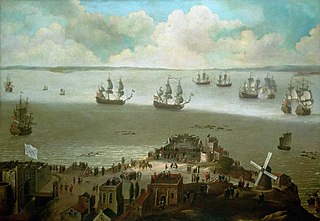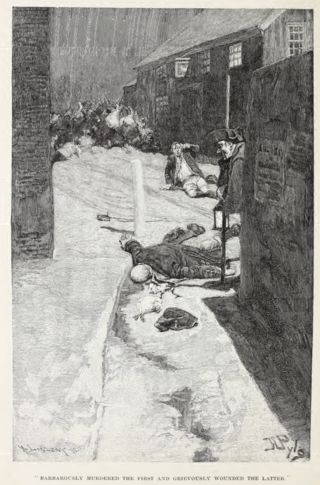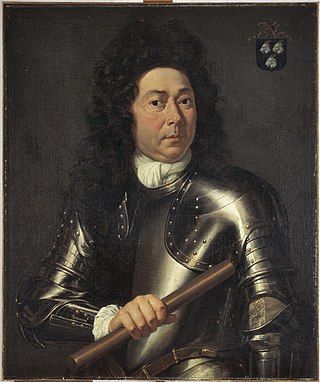Related Research Articles

A privateer is a private person or vessel which engages in commerce raiding under a commission of war. Since robbery under arms was a common aspect of seaborne trade, until the early 19th century all merchant ships carried arms. A sovereign or delegated authority issued commissions, also referred to as letters of marque, during wartime. The commission empowered the holder to carry on all forms of hostility permissible at sea by the usages of war. This included attacking foreign vessels and taking them as prizes and taking crews prisoner for exchange. Captured ships were subject to condemnation and sale under prize law, with the proceeds divided by percentage between the privateer's sponsors, shipowners, captains and crew. A percentage share usually went to the issuer of the commission.
Cinque Ports was an English ship whose sailing master was Alexander Selkirk, generally accepted as a model for the fictional Robinson Crusoe. The ship was part of a 1703 expedition commanded by William Dampier, who captained the accompanying ship, the 26-gun St George with a complement of 120 men.

HMS Speedy was a 14-gun Speedy-class brig of the British Royal Navy. Built during the last years of the American War of Independence, she served with distinction during the French Revolutionary Wars.
Fifteen ships and two shore establishments of the Royal Navy have borne the name HMS Ferret, after the domestic mammal, the Ferret:

Laurens Cornelis Boudewijn de Graaf was a Dutch pirate, mercenary, and naval officer in the service of the French colony of Saint-Domingue during the late 17th and early 18th century.

John Halsey was a British privateer and later a pirate who was active in the Atlantic and Indian Oceans during the early 18th century. Although much of his life and career is unknown, he is recorded in A General History of the Pyrates, which states "He was brave in his Person, courteous to all his Prisoners, lived beloved, and died regretted by his own People. His Grave was made in a garden of watermelons, and fenced in with Palisades to prevent his being rooted up by wild Hogs."

HMS Tyger, often spelled Tiger, was a 38-gun fourth rate frigate of the Royal Navy, built by Peter Pett II at Woolwich and launched in 1647. The term 'frigate' during the period of this ship referred to a method of construction, rather than a role which did not develop until the following century. Tyger was the third ship of the Royal Navy to bear the name, and by successive rebuildings she served for almost a century until she was wrecked in the Dry Tortugas in 1742. The ship's crew was stranded on Garden Key for 56 days, fighting off Spanish attempts to capture them, and then spent another 56 days sailing in small boats 700 miles (1,100 km) to Port Royal, Jamaica. Remarkably, only five crew members died during this period: three killed by the Spanish, and two others of natural causes. Six crewmen were captured and imprisoned by the Spanish. The captain and three of his lieutenants were court-martialed over the wreck and subsequent events.
Eleven ships of the Royal Navy have been named HMS Squirrel after the animal, while four more carried the name while serving as fishery protection vessels. Another was planned, but was renamed before being launched.

Van Tuyl is the surname of the Dutch family from which many North American Van Tuyls, Van Tuyles, Van Tyls and Van Tyles are descended. The family name derives from the ancient village of Tuil (Tuijl), in the central Netherlands. The family's earliest proven ancestor is the 14th-century knight Heer Ghijsbrecht van Tuyl of Gelre. This family is distinct from the Van Tuyll van Serooskerken family.

Lefebvre's Charles Town expedition was a combined French and Spanish attempt under Captain Jacques Lefebvre to capture the capital of the English Province of Carolina, Charles Town, during Queen Anne's War.
Thomas Mostyn was a British sea captain and slave trader active between New York and the Indian Ocean, and later in the Caribbean. He was one of the traders employed by New York merchant Frederick Philipse to smuggle supplies to the pirates of Madagascar.
Thomas Penniston was a privateer who operated out of New England. He was known for sailing alongside Adrian Claver and Regnier Tongrelow during Queen Anne's War. Penniston commanded the sloop Setty and sailed with Claver in 1704 against the French privateer Captain Davy. In early 1705 he operated against Spanish vessels off Venezuela and took at least one prize. In December 1705 Penniston sailed with Tongrelow and Nathaniel Burches for the West Indies to attack a French convoy. In early 1706 the Setty engaged an 18-gun vessel and a 24-gun vessel simultaneously and was badly damaged, she was lost with all hands whilst trying to sail to Jamaica.
Nathaniel “Nat” Burches was a privateer who operated out of New England. He was known for sailing alongside Regnier Tongrelow and Thomas Penniston, and for single-handedly defeating a huge Spanish ship.
Adrian Claver was a Dutch privateer based out of New England during Queen Anne's War. He sailed alongside other prominent privateers such as John Halsey, Regnier Tongrelow, and Thomas Penniston. Commanding the 18-gun ship Castel del Rey, Claver raided Spanish shipping off Havana in 1704 before accepting a commission to defend New York against the French privateer Captain Davy, though he failed to capture his target. In March 1705 with Halsey and Penniston he raided Spanish ships off Caracas. Claver was relieved of command of Castel del Rey by the ships owners in late 1705 and nothing further is known of him.

Captain Gincks was a privateer based in New York. He is best known for sailing alongside Adrian Claver, and for a violent incident involving his sailors while ashore.
Captain Crapo was a French privateer active in the Caribbean and off the American east coast during the War of Spanish Succession. He was highly successful, capturing a large number of English vessels which he sent back to his home ports in Martinique and Port Royal.
Captain Davy was a French privateer active off New England during Queen Anne’s War. He is best known for repeatedly evading capture by rival English and Dutch privateers including Adrian Claver and Thomas Penniston.
David Williams was a Welsh sailor who turned pirate after being abandoned on Madagascar. He was only briefly a captain, and is best known for sailing under a number of more prominent pirate captains.
Thomas Collins was a pirate active in the Indian Ocean. He is best known for leading a pirate settlement and trading post on Madagascar.

Philips van der Goes was a Dutch military officer during the 17th and 18th centuries. He took part in the Nine Years' War and the War of the Spanish Succession and ended his military career at the rank of vice-admiral.
References
- ↑ His name is spelled a number of ways: Tongerlou, Tongerlows, Tongrelou, Tongrelow, Tonguerlow, Toungrello, Tongrelo, Tongrelow, Tangrelot, et al. His first name is typically spelled Reiner, Renier, Rene, or Regnier.
- 1 2 3 Groenendijk, R. L. Van Tuyl and J. N. A. (1996). A Van Tuyl Chronicle: 650 Years in the History of a Dutch-American Family. Decorah IA: Rory Van Tuyl. pp. 128–129. Retrieved 5 November 2017.
- 1 2 3 4 5 Alden, Henry Mills; Allen, Frederick Lewis; Hartman, Lee Foster; Wells, Thomas Bucklin (1895). Harper's (Volume 90 ed.). New York: Harper's Magazine Foundation. pp. 335–339. Retrieved 5 November 2017.
- ↑ Weeks, Lyman Horace; Bacon, Edwin Monroe (1911). An Historical Digest of the Provincial Press: Being a Collation of All Items of Personal and Historic Reference Relating to American Affairs Printed in the Newspapers of the Provincial Period Beginning with the Appearance of The Present State of the New-English Affairs, 1689, Publick Occurrences, 1690, and the First Issue of the Boston News-letter, 1704, and Ending with the Close of the Revolution, 1783 ... Massachusetts Series, Volume One. Boston MA: Society for Americana, Incorporated. pp. 62–473. Retrieved 5 November 2017.
- 1 2 Fletcher, R. A. (2013). In The Days Of The Tall Ships. Worcestershire UK: Read Books Ltd. ISBN 9781473383456 . Retrieved 5 November 2017.
- ↑ Little, Benerson (2005). The Sea Rover's Practice: Pirate Tactics and Techniques, 1630-1730. Washington DC: Potomac Books, Inc. ISBN 9781574889109 . Retrieved 5 November 2017.
- ↑ Manhattan Company, Bank of the (1915). SHIPS AND SHIPPING OF OLD NEW YORK. New York: Walton Advertising and Printing Company. p. 27. Retrieved 5 November 2017.
